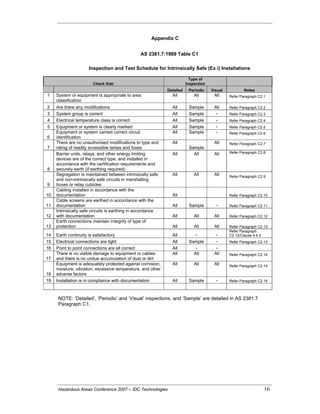Getting The Roar Solutions To Work
Getting The Roar Solutions To Work
Blog Article
The 10-Minute Rule for Roar Solutions
Table of ContentsWhat Does Roar Solutions Do?Not known Incorrect Statements About Roar Solutions Some Of Roar Solutions
In order to protect installments from a possible explosion an approach of evaluating and classifying a potentially harmful location is called for. The objective of this is to guarantee the proper choice and installation of equipment to inevitably protect against an explosion and to ensure security of life.
(https://telegra.ph/Roar-Training-Solutions-and-EEHA-Courses-Your-Gateway-to-Emergency-Care-Expertise-12-02)
No equipment needs to be installed where the surface area temperature level of the equipment is above the ignition temperature level of the offered threat. Below are some common dirt hazardous and their minimum ignition temperature level. Coal Dirt 380C 225C Polythene 420C (thaws) Methyl Cellulose 420C 320C Starch 460C 435C Flour 490C 340C Sugar 490C 460C Grain Dirt 510C 300C Phenolic Material 530C > 450C Aluminium 590C > 450C PVC 700C > 450C Residue 810C 570C The chance of the hazard being present in a focus high enough to cause an ignition will vary from area to location.
Harmful area electrical devices possibly made for use in higher ambient temperatures. Area Fixing By Authorised Personnel: Complex screening might not be called for however certain treatments might require to be followed in order for the equipment to preserve its third party score. Each item of tools with an unsafe score must be reviewed individually.
The Basic Principles Of Roar Solutions
The equipment register is an extensive database of tools documents that consists of a minimum set of areas to recognize each product's place, technological criteria, Ex lover classification, age, and ecological information. This info is important for tracking and taking care of the tools successfully within dangerous areas. On the other hand, for regular or RBI sampling inspections, the quality will be a mix of Thorough and Close assessments. The ratio of Thorough to Close inspections will certainly be identified by the Equipment Danger, which is evaluated based on ignition threat (the likelihood of a source of ignition versus the chance of a flammable ambience )and the harmful location classification
( Area 0, 1, or 2). This variation will certainly also affect the resourcing requirements for job preparation. When Lots are specified, you can develop sampling strategies based upon the example dimension of each Lot, which describes the number of arbitrary equipment products to be evaluated. To figure out the called for sample dimension, two facets need to be examined: the dimension of the Lot and the group of evaluation, which shows the level of effort that must be used( decreased, typical, or raised )to the evaluation of the Whole lot. By combining the classification of examination with the Lot size, you can then develop the ideal rejection requirements for an example, suggesting the allowable number of malfunctioning things found within that sample. For more details on this process, please describe the Power Institute Standards. The IEC 60079 basic suggests that the optimum interval between evaluations need to not exceed 3 years. EEHA inspections will certainly also be conducted outside of RBI projects as part of scheduled maintenance and equipment overhauls or repair work. These evaluations can be credited toward the RBI sample dimensions within the his comment is here influenced Whole lots. EEHA inspections are conducted to identify mistakes in electric devices. A heavy scoring system is vital, as a solitary tool may have multiple mistakes, each with differing degrees of ignition danger. If the combined score of both examinations is much less than two times the fault score, the Lot is regarded appropriate. If the Great deal is still considered inappropriate, it needs to go through a full inspection or justification, which might activate stricter examination methods. Accepted Great deal: The root causes of any kind of mistakes are identified. If a typical failure setting is discovered, additional tools may require maintenance. Faults are classified by severity( Safety and security, Stability, Housekeeping ), making certain that urgent issues are analyzed and dealt with promptly to minimize any influence on security or operations. The EEHA database should track and tape the lifecycle of faults together with the corrective activities taken. Implementing a durable Risk-Based Inspection( RBI )method is essential for ensuring compliance and safety and security in managing Electric Tools in Hazardous Areas( EEHA) (hazardous area electrical course). Automated Fault Scoring and Lifecycle Administration: Easily manage faults and track their lifecycle to boost inspection accuracy. The intro of this assistance for risk-based examination better strengthens Inspectivity's setting as a best-in-class remedy for governing compliance, in addition to for any type of asset-centric examination use case. If you have an interest in discovering more, we invite you to request a presentation and find exactly how our remedy can change your EEHA monitoring processes.
Excitement About Roar Solutions

In terms of eruptive threat, a hazardous location is a setting in which an eruptive environment is existing (or may be expected to be present) in quantities that need special precautions for the building and construction, installation and usage of tools. Roar Training Solutions. In this post we check out the obstacles faced in the office, the threat control procedures, and the needed competencies to work safely
It issues of contemporary life that we manufacture, save or manage a series of gases or fluids that are deemed combustible, and a series of dirts that are deemed flammable. These compounds can, in particular problems, form explosive atmospheres and these can have significant and unfortunate repercussions. A lot of us know with the fire triangle remove any type of one of the 3 elements and the fire can not take place, however what does this mean in the context of hazardous locations? When breaking this down right into its simplest terms it is basically: a combination of a specific amount of launch or leakage of a certain substance or product, blending with ambient oxygen, and the visibility of a source of ignition.
In most circumstances, we can do little concerning the levels of oxygen in the air, however we can have significant influence on sources of ignition, as an example electric equipment. Dangerous locations are recorded on the hazardous area category illustration and are recognized on-site by the triangular "EX" indication. Right here, among other crucial details, areas are divided into three types relying on the threat, the probability and period that an eruptive atmosphere will exist; Zone 0 or 20 is regarded one of the most hazardous and Zone 2 or 22 is considered the least.
Report this page